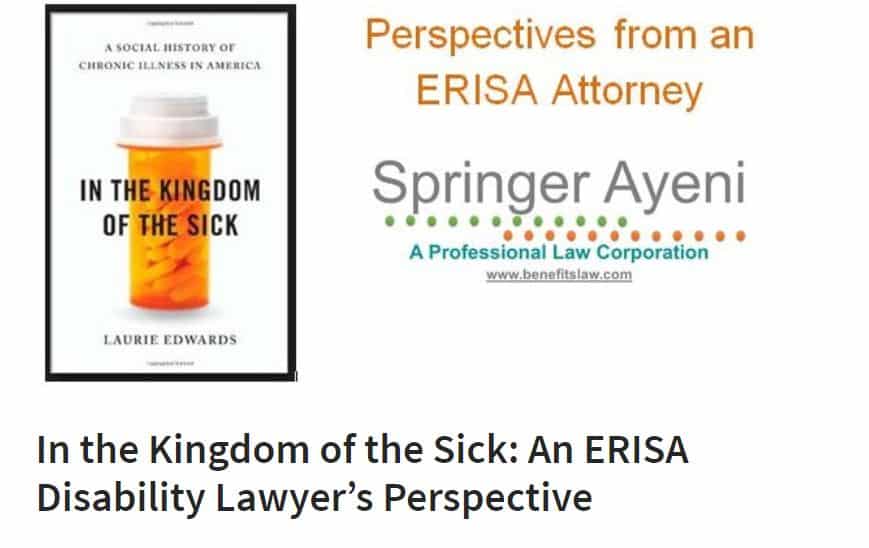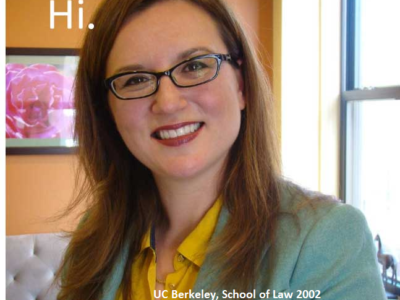Home » Benefits Insurance Claims » In the Kingdom of the Sick: An ERISA Disability Lawyer’s Perspective

In the Kingdom of the Sick: An ERISA Disability Lawyer’s Perspective
In the Kingdom of the Sick: An ERISA Disability Lawyer’s Perspective
By Cassie Springer Ayeni
Springer Ayeni, A Professional Law Corporation
“‘Illness is the night-side of life, a more onerous citizenship. Everyone who is born holds dual citizenship, in the kingdom of the well and the kingdom of the sick . . . sooner or later each of us is obliged, at least for a spell, to identify ourselves as citizens of that other place.’” – In the Kingdom of the Sick at p. 4 (quoting Susan Sontag).
In Laurie Edwards’s book on chronic illness, In the Kingdom of the Sick: A Social History of Chronic Illness in America, she takes a broad approach to explain obstacles that people suffering from chronic illness currently encounter.
Chronic Illness Defined
Edwards identifies three primary traits in chronic illness: “the symptoms are invisible, symptoms and disease progression vary from person to person, and the disease progression and worsening or improvement of symptoms are impossible to predict.” (pp. 32-33.) She also notes that chronic illness is “treatable, not curable.” (p. 33.) Moreover, chronic illness is often accompanied by its life-altering companion, chronic pain, which can make it “excruciating to engage in physical activities, keep up with a regular work schedule, or even leave the house.” (p. 111.) And it is pervasive. According to Edwards, chronic illness, which includes heart disease, diabetes, cancer, and asthma, affects nearly 50% of the population. (p. 11.) An astounding 81% of hospital admissions are a result of chronic illness, as are 76% of all physician visits. (p. 11.)
Biases Against People with Chronic Illnesses
Edwards devotes much of In the Kingdom of the Sick to explaining the biases that those living with chronic illness encounter, both from an historical perspective and in the modern medical era. For example, Edwards notes that where conditions lack a cure, which is one of the inherent traits of chronic illness, “blaming the patient often follows suit.” (p. 6.) This bias of skepticism leads to potentially devastating consequences: “45 percent of patients with autoimmune disease were labeled as chronic complainers early in their diagnostic journeys, with the resulting delay in diagnosis often leading to organ damage from lack of appropriate treatment.” (p. 78.) In my experience representing ERISA disability claimants for the past 15 years, this inclination towards disbelief extends to the disability insurance context as well, where before a concrete diagnosis is reached insurers are inclined to deny a claim for disability benefits that are based on “self-reported symptoms,” and claimants who cannot seem to overcome their undiagnosed or misunderstood conditions are labeled as “malingerers.” Indeed, these biases have become so pervasive that the trend in long-term disability plans is to limit the duration of benefits payable for “self-reported conditions,” which is an ever-expanding group of non-fatal, but totally disabling conditions. Claimants are often left high and dry after receiving the maximum duration of benefits, but still prevented by their lifelong illnesses from returning to gainful employment.
Additionally, most ERISA disability plans are written with a 24-month or shorter maximum duration for “mental illness” conditions. However, as Edwards points out, people with chronic illness often have secondary depression and anxiety: “what if the person is anxious because he or she has been sick for weeks or months and physicians can’t seem to help? What if the person is depressed because he or she is at home sick, isolated from social events and falling behind in work?” (p. 107.) In my experience, many disability claims adjusters try to label the mental component as primary in order to justify limited payment duration, often ignoring the severity of the underlying physical condition.
Edwards also does an excellent job examining the historical and pervasive bias against illnesses that primarily strike women. She states: “throughout history, deeply ingrained ideas about women as unreliable narrators of their pain and symptoms, as weaker than men, and as histrionic or otherwise ‘emotional’ have had a profound impact on their ability to receive accurate diagnoses and appropriate care.” (p. 20.) Added to this inherent bias is the fact that until very recently, “[w]omen were navigating a hierarchical medical system dominated by males; women lacked knowledge and resources to advocate for their health.” (pp. 76-77.) Although times are changing as there are more women doctors and as studies are increasingly inclusive of women patients, women with chronic illnesses still encounter shades of these gender biases when diagnosed with conditions like chronic fatigue syndrome, where people “roll their eyes at [these patients] or come right out and tell [them] that CFS is a made up disease, a present-day hysteria, or that ‘everybody gets tired.’” (p. 103.)
Chronic Illness and ERISA Claimants
Edwards aptly notes that people with chronic illnesses are often not able to be accommodated by their employers, since the ability to maintain a regular work schedule is a job necessity. (p. 66.) A disability claim is the inevitable conclusion, where the claimants must then “prove” their disability to the insurer. However, the insurer may be skeptical because of the nature of chronic illness, where sufferers experience some days that are better than others. Edwards notes that such fluctuation is a hallmark of chronic illness: “The unpredictability of symptoms and their severity that sets chronic illness apart from certain physical disabilities can also make for ‘unreliable activists,’ individuals who might be able to run workshops or attend policy meetings one day and be bedridden the very next.” (p. 53.) The chronically ill ERISA claimant may encounter the same culture of skepticism in the insurance context that she likely already experienced when seeking treatment for what ultimately became a disabling condition. And this culture of disbelief extends to the health benefit context as well. Edwards poignantly recounts her own experience with chronic illness, stating “I am grateful for the excellent health insurance that I work incredibly hard to provide for my family, and even with that, there are always letters to write, explanations to offer, and battles to wage to convince the people in charge of approving claims that preventative care is truly medically necessary.” (p. 193.)
Skepticism in LTD benefit applications couples with the shame that many chronically ill patients experience in admitting disability to begin with. Edward quotes the experience of one woman who had to apply for Social Security Disability Insurance, which is often a requirement of ERISA LTD applicants: “‘I’m depressed about it because I prefer to live in denial that this is going to be a long-lasting or permanent condition. And I’m embarrassed because even though rationally I know SSDI is an insurance policy that I paid into since I got my first job at age fourteen, it feels like asking for a handout. Like it’s trying to go on welfare.’” (p. 55.)
And still another obstacle faced by many ERISA LTD applicants who are chronically ill is the shock of surveillance that captures “clustering” activities to periods of increased energy, which often then results of days of bed rest to make up for the exertion. Edwards notes that such behavior is a pain management technique rather than an indication of sustained energy, and details that chronically ill patients must engage in extensive planning ahead of time before engaging in everyday routines. (p. 103.)
A Validating Resource for Patients
Overall, In the Kingdom of the Sick is an excellent resource for people suffering from chronic illnesses to obtain comfort that their experiences of disbelief, bias, and isolation are not unique. However, because chronic illness is such an extensive topic, at times the book is painted in too-broad strokes. Edwards tries too hard to lump all chronic illnesses together, such as AIDS, CFIDS, and cancer, to draw the tenuous analogy that people are biased universally against those with chronic illness. The diseases and the movements behind the diseases may have some links, but are also very distinct, and each disease has its own social bias to overcome to generate more attention and funding.
In this lumping together, Edwards also misses the distinguishing factor in chronic pain conditions – most are not inherently fatal. She criticizes that the NIH spends 96% less money on chronic pain research than on cancer, cardiovascular disease, and diabetes combined, but these are all potentially life-threatening whereas chronic pain is perceived as more manageable.
Nevertheless, I would certainly recommend that my clients who are suffering from debilitating chronic illnesses read In the Kingdom of the Sick to understand the historical context of chronic illness and to understand the legitimacy of their own experiences and feelings surrounding their illnesses. I would also recommend that attorneys and doctors alike who are interested in being more compassionate caretakers of their clients and patients read this book. And, in a dream world, every insurance claims adjuster would read it too before making assumptions tinged with societal bias.
Cassie Springer Ayeni is the President and Founder of Springer Ayeni, A Professional Law Corporation, in Oakland, CA, where she focuses on ERISA disability and life insurance cases. She can be reached atcassie@benefitslaw.com or www.benefitslaw.com


